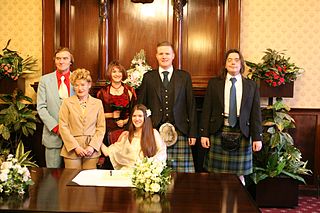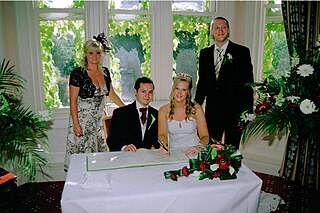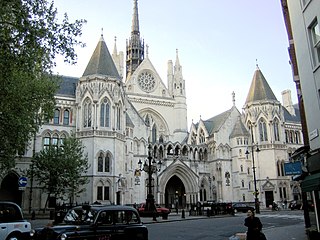Divorce is the process of terminating a marriage or marital union. Divorce usually entails the canceling or reorganizing of the legal duties and responsibilities of marriage, thus dissolving the bonds of matrimony between a married couple under the rule of law of the particular country or state. Divorce laws vary considerably around the world, but in most countries, divorce requires the sanction of a court or other authority in a legal process, which may involve issues of distribution of property, child custody, alimony, child visitation / access, parenting time, child support, and division of debt. In most countries, monogamy is required by law, so divorce allows each former partner to marry another person.
Common-law marriage, also known as non-ceremonial marriage, sui iuris marriage, informal marriage, or marriage by habit and repute, is a legal framework where a couple may be considered married without having formally registered their relation as a civil or religious marriage.
Annulment is a legal procedure within secular and religious legal systems for declaring a marriage null and void. Unlike divorce, it is usually retroactive, meaning that an annulled marriage is considered to be invalid from the beginning almost as if it had never taken place. In legal terminology, an annulment makes a void marriage or a voidable marriage null.
Civil partnership in the United Kingdom is a form of civil union between couples open to both same-sex couples and opposite-sex couples.
The Parliament of Canada has exclusive legislative authority over marriage and divorce in Canada under section 91(26) of the Constitution Act, 1867. However section 92(12) of the Constitution Act, 1867 gives the provincial legislatures the power to pass laws regulating the solemnization of marriage.
In a no-fault divorce the dissolution of a marriage does not require a showing of wrongdoing by either party. Laws providing for no-fault divorce allow a family court to grant a divorce in response to a petition by either party of the marriage without requiring the petitioner to provide evidence that the defendant has committed a breach of the marital contract.
Australian family law is principally found in the federal Family Law Act 1975 and the Federal Circuit and Family Court of Australia Rules 2021 as well as in other laws and the common law and laws of equity, which affect the family and the relationship between those people, including when those relationships end. Most family law is practised in the Federal Circuit and Family Court of Australia or the Federal Circuit and Family Court of Western Australia, depending on the location and complexity of the matter. Australia recognises marriages entered into overseas as well as divorces obtained overseas if they were effected in accordance with the laws of that country. Australian marriage and "matrimonial causes" are recognised by sections 51(xxi) and (xxii) of the Constitution of Australia and internationally by marriage law and conventions, such as the Hague Convention on Marriages (1978).

Marriage is available in England and Wales to both opposite-sex and same-sex couples and is legally recognised in the forms of both civil and religious marriage. Marriage laws have historically evolved separately from marriage laws in other jurisdictions in the United Kingdom. There is a distinction between religious marriages, conducted by an authorised religious celebrant and civil marriages conducted by a state registrar. The legal minimum age to enter into a marriage in England and Wales is sixteen years, although this requires consent of parents and guardians if a participant is under eighteen. Certain relatives are not allowed to marry. For foreign nationals, there are also residency conditions that have to be met before people can be married. Same-sex marriage was introduced under the Marriage Act in March 2014.
This article is a general overview of divorce laws around the world. Every nation in the world allows its residents to divorce under some conditions except the Philippines and the Vatican City, an ecclesiastical sovereign city-state, which has no procedure for divorce. In these two countries, laws only allow annulment of marriages.

Family law in Canada concerns the body of Canadian law dealing with domestic partnerships, marriage, and divorce.

Marriage in Scotland is recognised in the form of both civil and religious unions between individuals. Historically, the law of marriage has developed differently in Scotland to other jurisdictions in the United Kingdom as a consequence of the differences in Scots law and role of the separate established Church of Scotland. These differences led to a tradition of couples from England and Wales eloping to Scotland, most famously to marry at border towns such as Gretna Green. The legal minimum age to enter into a marriage in Scotland is sixteen years and does not require parental consent at any age.
South African family law is concerned with those legal rules in South Africa which pertain to familial relationships. It may be defined as "that subdivision of material private law which researches, describes and regulates the origin, contents and dissolution of all legal relationships between: (i) husband and wife ; (ii) parents, guardians and children; and (iii) relatives related through blood and affinity."
"As far as family law is concerned, we in South Africa have it all. We have every kind of family; extended families, nuclear families, one-parent families, same-sex families, and in relation to each one of these there are controversy, difficulties and cases coming before the courts or due to come before the courts. This is the result of ancient history and recent history [...]. Our families are suffused with history, as family law is suffused with history, culture, belief and personality. For researchers it's a paradise, for judges a purgatory."

The Clandestine Marriages Act 1753, long title "An Act for the Better Preventing of Clandestine Marriage", popularly known as Lord Hardwicke's Marriage Act, was the first statutory legislation in England and Wales to require a formal ceremony of marriage. It came into force on 25 March 1754. The Act contributed to a dispute about the validity of a Scottish marriage, although pressure to address the problem of irregular marriages had been growing for some time.
Divorcein South African law refers to the termination of a marital union, the canceling of the legal duties and responsibilities of marriage and the dissolving of the bonds of matrimony between a married couple. Divorce is unlike annulment, which declares the marriage null and void. Divorce requires the sanction of a court in a legal process. The legal process of divorce may also involve issues of alimony, child custody, child support, distribution of property and division of debt.
Actions for divorce in Scotland may be brought in either the Sheriff Court or the Court of Session. In practice, it is only actions in which unusually large sums of money are in dispute, or with an international element, that are raised in the Court of Session. If, as is usual, there are no contentious issues, it is not necessary to employ a lawyer.

Marriage in Australia is regulated by the federal government, which is granted the power to make laws regarding marriage by section 51(xxi) of the constitution. The Marriage Act 1961 applies uniformly throughout Australia to the exclusion of all state laws on the subject.

A civil, or registrar, ceremony is a non-religious legal marriage ceremony performed by a government official or functionary. In the United Kingdom, this person is typically called a registrar. In the United States, civil ceremonies may be performed by town, city, or county clerks, judges or justices of the peace, or others possessing the legal authority to support the marriage as the wedding officiant.
The Adoption and Children (Scotland) Act 2007 is an Act of the Scottish Parliament and the chief source of law relating to adoption in Scotland.

Legal capacity is the ability of an individual to transact with others. It should be distinguished from consent, where the individual with capacity, agrees for another to commit an act involving the consenter, such as consent to sexual relations under the Sexual Offences (Scotland) Act 2009.

Ahkter v Khan[2020] EWCA 122, also known as Attorney General v Ahkter, is an English family law Court of Appeal case concerning the validity of an Islamic ceremony of marriage. A woman who recently divorced her husband petitioned the court to determine whether the marriage, resulting from a Nikah, was void marriage or a non-marriage. The Family Court had held the marriage was void, granting her financial remedies. The Court of Appeal subsequently reversed the decision and denied financial remedies. The case received much scholarly and media attention on the requirements for marriage and the protection of vulnerable spouses.









